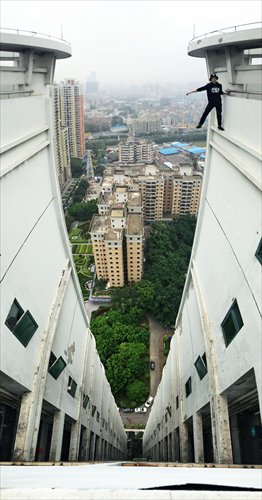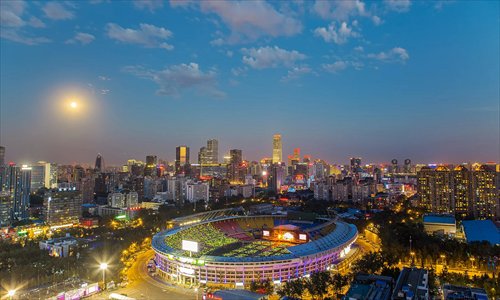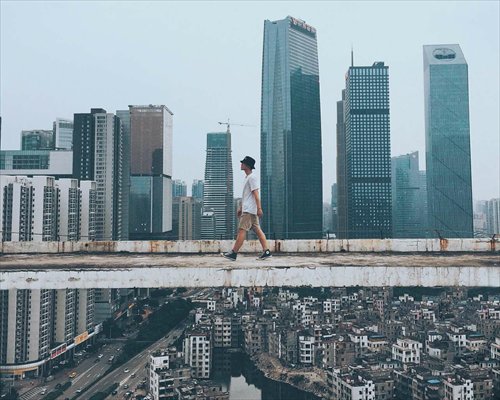Rooftopping pushes the limits
Taking photography to new heights

A man tries rooftopping in Guangzhou, Guangdong Province. Photo: Courtesy of Liang Zhongkang
Being suspended from a 30-storey building is enough to scare most people, but for 24-year-old Liang Zhongkang, it was an opportunity to try something adventurous. He made his way to the edge of a rooftop of a skyscraper in Guangzhou, Guangdong Province, on a cloudy day in January. Instead of just standing on the edge, Liang stood on a skateboard, half of it dangling in midair. The e-commerce professional was not just performing a breathtaking stunt, but also shooting photos from this unique angle. It's a new trend called rooftopping.
This adventurous style of photography requires photographers to go to the very tops of buildings reaching over the edges to capture the perfect picture.
Liang was not satisfied with his initial shoot, so he went back several more times. One time, he nearly lost his balance, but luckily, managed to steady himself.
"I was exhilarated when I made it. I wanted to try this because very few people are daring enough to give it a try. Rooftopping is so challenging and interesting," Liang said.
He is one of only a few daredevils in China who are rooftopping. After seeing a series of rooftopping photos on messaging service WeChat last October, Liang immediately wanted to be part of this growing trend.
Liang then started a rooftopping topic group on Sina Weibo, which has since received more than 19,000 hits. Some followers have even shared their rooftopping photos on the platform.

Li Jinfeng stands on the top of a skyscraper in Taiyuan, Shanxi Province. Photo: Courtesy of Li Jinfeng
City collection
In June 2013, Li Jinfeng, 24, who was on a break from his internship at a local electricity company in Taiyuan, Shanxi Province, bought a camera to go rooftopping. "I used to parkour and I'm adventurous. I like to try new and challenging things," Li said, explaining his initial reason for rooftopping.
During the process, Li's goal gradually changed, to "using rooftopping to document the changes of the city [in which I live]." "Unlike shooting photos on ground level, rooftopping offers a wider angle and you can see more when you stand higher up."
Li climbed to the highest building in Taiyuan last December while it was still under construction, for a special night shoot.
"I always keep an eye on newly-built buildings. The ideal conditions for rooftopping are picking a tall building and on a good day," Li said.
Yan Jie, a 28-year-old photographer, told Metropolitan the joy rooftopping brings him is to use photos to document the city of Beijing. "Many people like to collect [pictures of] the city, such as doorplates. My way of documenting Beijing is to take pictures of the landmark buildings."
His rooftopping collection covers the central business district (CBD) area, Wangjing in Chaoyang district and buildings including the Beijing Television Station and Fortune Plaza.

A night view of the CBD area in Chaoyang district taken from the rooftops. Photo: Courtesy of Yan Lei
Trouble getting to the top
However, rooftopping has its challenges - the most difficult part of which is getting to the rooftop itself. "I pick a building based on its height. The higher the better," said Liang. "Sometimes I have to break a locked door to make my way to the rooftop, as many rooftops are locked and entry forbidden. But some locks are really hard to break. So I mostly go to the top of residential buildings, which are open."
Yan has also experienced difficulties in accessing the rooftops.
"For example, most good places in the CBD area are locked. Many times I have to use guanxi [connections ] to find a way for rooftopping," he said.
Li is a member of a photographers' association and has a press licence, making it easier for him to request access to rooftops.
Another difficulty Yan has experienced is that he has to carry heavy photographic equipment and climb dozens of stairs to reach the top of buildings. "It [rooftopping] is also a test of physical strength and endurance. What I remember vividly is one time, after several days of shooting, I had to climb a building in Wangjing that was over 50 storeys high with more than 15 kilograms of cameras and a tripod. I was very exhausted but it was very worthwhile."
The frequent smoggy weather in Beijing also poses an obstacle to rooftopping, said Yan.
"It's rare to see professional photographers doing this. Rooftopping does not bring in much money, so it's impossible for professionals to make a living from it. It's just a hobby," Yan added.
Still, Liang has encouraged ordinary people to give it a try, even acrophobics.
"I have a friend who used to feel uncomfortable on a building more than 10 storeys high, but now can climb to over 50 storeys for rooftopping. You succeed when you overcome your fear," said Liang.

A rooftopping enthusiast poses for the camera above the Guangzhou skyline. Photo: Courtesy of Liang Zhongkang
Going to the extreme
Yan Lei, 33, one of the first photographers to try rooftopping in China five years ago, has noted differences in rooftopping here and in Western countries.
"The introduction of rooftopping in China started about five years ago, one year after our Western counterparts. We are unlike them, in that they take rooftopping to the extreme and perform dangerous movements on the buildings. We are still more focused on the photography part and most of us just shoot photos from the rooftop, rather than performing stunts as well," Yan Lei said.
Since rooftopping first began, the number of rooftopping photographers has increased about four- to five-fold, said Yan Lei. He told Metropolitan he doesn't like to show photos of himself standing on the very edge of a building, fearing that others might try to do the same. "I have a friend who several days ago sat on the edge of a building in Fengtai district, to do rooftopping. A passerby saw him and reported him to the police. He was then taken to the police station for interrogation."
Li said because of the difficulties and dangers involved, few people persist with rooftopping. Although he has been doing it for more than two years, he's still addicted to it. "Every time when the weather changes, the photos you shoot are different."
Li emphasized that rooftopping does not have to be dangerous. "I know my limits and I won't challenge myself too far," he said. "What's important is that you should have the right intentions and only do rooftopping if you can guarantee your safety. Eventually you should let your photos do the talking, not how dangerous it was to capture them."